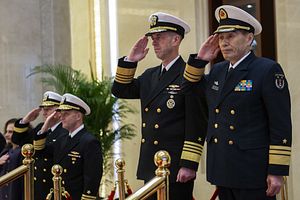The heads of the U.S. and Chinese navies talked over a video teleconference on July 9. Admiral John Richardson of the U.S. Navy and Admiral Shen Jinlong of the PLA Navy discussed recurring themes for increasing safety and reducing miscalculation when the two countries’ ships and aircraft interact.
The U.S. Navy said that the talks focused on “reducing strategic, operational and tactical risk between the two navies with the goal to minimize the possibility of any misunderstanding or miscalculation.” Admiral Richardson has spoken before about his concerns that even an incident at the tactical level between individual ships or aircraft could quickly escalate into a strategic incident through misunderstanding of intentions.
While most interactions between U.S. and Chinese naval units are safe and professional, U.S. Navy surveillance aircraft are periodically harassed by Chinese jets and last fall the USS Decatur was aggressively cut-off by a Chinese destroyer in the South China Sea in a maneuver that risked a collision.
The discussion was the latest in a regular series of contacts between the two leaders to maintain open communications and positive military-to-military relations. The two admirals have held four video teleconferences and have met in person twice.
This is likely to be Admiral Richardson’s last contact with his Chinese counterpart. He is required by law to step down as Chief of Naval Operations in September after four years in the position.
The leadership of the U.S. Navy was thrown into unexpected turmoil when Admiral Richardson’s nominated successor, Admiral William Moran, abruptly withdrew his name from confirmation and announced that he would be retiring instead following concerns about his continuing contacts with an officer who was disciplined for inappropriate conduct. The U.S. Secretary of the Navy said that the episode brought the Admiral’s professional judgement into question.
Admiral Moran was central to the U.S. Navy’s response to the deadly collisions involving the USS Fitzgerald and USS John S. McCain in the Pacific in 2017, and co-chaired the navy’s senior oversight body charged with implementing reforms to repair the institutional deficiencies that contributed to the collisions, restore the fleet’s readiness, and improve its warfighting ability.
With Admiral Moran’s withdrawal, the secretary of the Navy surprised many by selecting a relatively junior three-star officer, Vice Admiral Mike Gilday, for the position. The move by-passes all current four-star Admirals, who the Secretary said were needed where they were to maintain effective continuity. The choice is not unprecedented but has not happened in decades; a three-star officer was promoted this way in 1970 and in 1955 a two-star admiral was promoted ahead of all three- and four-star officers to lead the navy.
Admiral Gilday is also a unique choice because in addition to his commands at-sea, he has significant cyber experience, possibly signaling the Navy’s concern about cyber vulnerabilities and elevating cyber concerns alongside more traditional Navy emphasis on ships, planes, and submarines. Gilday is a former head of the U.S. Navy’s 10th Fleet, responsible for the Navy’s cyber forces and capabilities, and as director of operations for the U.S. Cyber Command.

































